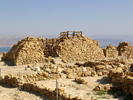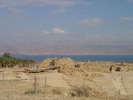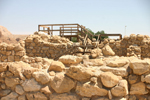Tower

Introduction
One of the most visually striking architectural remains at Khirbet Qumran is the tower at the northwestern corner of the courtyard of the main building. This tower, with its impressive glacis (sloping stone rampart base), has been the focus of much of the debate concerning the nature of the Qumran settlement and its inhabitants. Different purposes have been proposed for the fortified structure by those who would view Qumran as a military fortress, a fortified manor, a villa, or the center of a religious community.
De Vaux had proposed that the tower was erected during the main building phase of the community settlement (“period Ib,” 1st century BCE; see Archaeology Timeline ), to serve as a watchtower for general security purposes. In his reconstruction, the glacis was added as part of a general reinforcement of the site at the turn of the millennium, when the sectarian occupants returned after a period of abandonment following an earthquake in 31 BCE.
In her revision of De Vaux’s archaeological chronology, Jodi Magness accepts the basic proposal that the tower was built as part of the early sectarian settlement, and strengthened after the earthquake. She suggests, however that the occupants did not temporarily abandon the site, but rather began repairs immediately following the earthquake.
Norman Golb argues that the tower shows that Qumran was never a civilian religious center, but was rather a military fortress http://www.jstor.org/stable/pdfplus/545734.pdf . His claim has not been accepted by archaeologists, who note that he does not account for civilian aspects of the site, such as the presence of industrial workshops. Unlike contemporary structures that can be identified as royal Hasmonean and Herodian fortresses (such as Masada or Herodium), Qumran is not built on a mountaintop, and it is not named in historical sources. The plan of the Qumran site differs from these fortresses as well. Yizhar Hirschfeld has noted that Roman military fortresses typically have just a single entrance, as compared to the multiple entrances at Qumran, and that fortresses feature a large courtyard, also absent at Qumran.
For Hirschfeld, the architectural elements of Qumran—the tower, living quarters, industrial and agricultural installations—indicate that the site was a fortified manor house. http://www.jstor.org/stable/545860 He noted that contemporary agricultural estates often contain high towers, and he believed that the glacis was constructed as an integral part of the tower, rather than having been added later. Magness has countered that the significance of the similarities to agricultural estates observed by Hirschfeld are outweighed by the differences between Qumran and these sites. Qumran is distinguished by its miqva’ot, or ritual baths (see Water System); by the absence of interior decorative features (such as frescoes and and mosaic floors, usually found at private residences), and by the nature of the pottery and small finds associated with the site.
More Info
- Norman Golb, “Khirbet Qumran and the Manuscripts of the Judaean Wilderness: Observations on the Logic of Their Investigation,” Journal of Near Eastern Studies 49/2 (1990): 103–114 http://www.jstor.org/stable/pdfplus/545734.pdf
- Yizhar Hirschfeld, “Early Roman Manor Houses in Judea and the Site of Khirbet Qumran,” Journal of Near Eastern Studies, 57/3 (1998): 161–189
- Yizhar Hirschfeld, “Qumran in the Second Temple Period: Reassessing the Archaeological Evidence,” Liber Annuus 52 (2002): 247–296 http://198.62.75.1/www1/ofm/sbf/Books/LA52/LA52247Hirschfeld_Qumran.pdf
- Jodi Magness, The Archaeology of Qumran and the Dead Sea Scrolls (Grand Rapids: Eerdmans, 2002)
- Jodi Magness, “Review: Yizhar Hirschfeld, Qumran in Context; Reassessing the Archaeological Evidence,” Review of Biblical Literature 8 (2006): 87–100 http://www.bookreviews.org/pdf/4500_4560.pdf>
- Hershel Shanks, “The Qumran Settlement—Monastery, Villa or Fortress?” Biblical Archaeological Review 19/3 (1993): 62–65.


